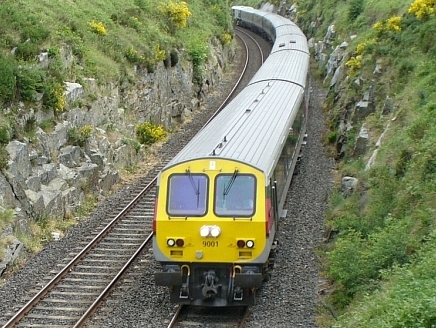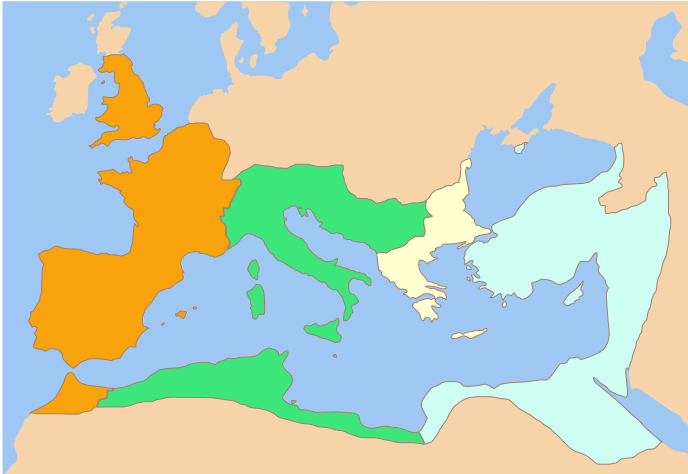|
InterCity (Iarnród Éireann)
InterCity ( ga, IdirChathrach) is the brand name given to rail services operated by Iarnród Éireann that run between Dublin and other major cities in Ireland. InterCity branding is also used in other European countries by unaffiliated organizations. Services InterCity services from Dublin operate from two main stations: * - Heuston Station is the terminus for services to the south and west of Ireland. Services from Heuston operate to Cork, Galway, Waterford, Tralee, Westport and Limerick. * - Connolly Station is the terminus for services to the east and north-west of Ireland. Services from Connolly operate to Sligo and Rosslare Europort. Dublin Connolly is also the terminus of the Dublin to Belfast main line, with services to provided by Enterprise. Rolling stock InterCity services are operated using a mixture of locomotive pulled coaching stock and DMUs. In 2006, deliveries began of 67 new Mark 4 coaches, specifically for the flagship Dublin-Cork route, in an order cost ... [...More Info...] [...Related Items...] OR: [Wikipedia] [Google] [Baidu] |
IE 22000 Class
The 22000 Class "InterCity Railcar" is a diesel multiple unit in service with Iarnród Éireann in Ireland. They are the first IÉ DMUs built specifically for InterCity routes, although they can also work on some commuter routes. They are designed to operate at a maximum speed of History In 2005, the Irish Government announced the €34 billion Transport 21 proposal for significant improvements to transport infrastructure, with major emphasis on the railway network. As part of this, large-scale replacement of rolling stock was planned, then made up entirely of locomotive-hauled coaching stock, the most based on the British Rail Mark 2 and Mark 3. IÉ ordered 120 replacement vehicles: in a major departure, the new trains would be 3 and 6 car DMUs rather than locomotive-hauled carriages. This order was extended to 150 vehicles in 2005, to 183 vehicles in 2007 and to 234 vehicles in December 2008. 41 additional centre cars were ordered in 2019 for delivery from 2021. No new d ... [...More Info...] [...Related Items...] OR: [Wikipedia] [Google] [Baidu] |
Coaching Stock Of Ireland
A wide variety of hauled coaches have been used on the railways of Ireland. This page lists all those since 1945. Ireland When formed in 1945, Córas Iompair Éireann (CIÉ) inherited from its constituents a motley collection of coaching stock from various manufacturers, in equally variegated conditions of repair. Although many were over 40 years old they had to remain in service until a programme of replacement could be found. CIÉ, which controlled the Republic's railways between 1945 and 1987, and its subsidiary, Iarnród Éireann (IÉ) from 2 February 1987, have made great use of hauled coaches, though in recent years IÉ has turned increasingly to multiple units to replace old locomotives and coaches. IÉ and NIR jointly own the current stock used on the ''Enterprise'' service between Dublin and Belfast, with IÉ nominally owning the odd-numbered vehicles and NIR the even-numbered ones, though all share a common ''Enterprise'' livery. Current stock De Dietrich (1997–pre ... [...More Info...] [...Related Items...] OR: [Wikipedia] [Google] [Baidu] |
Mark 4 DVT At Kent Station (Cork)-106623 (cropped)
Mark may refer to: Currency * Bosnia and Herzegovina convertible mark, the currency of Bosnia and Herzegovina * East German mark, the currency of the German Democratic Republic * Estonian mark, the currency of Estonia between 1918 and 1927 * Finnish markka ( sv, finsk mark, links=no), the currency of Finland from 1860 until 28 February 2002 * Mark (currency), a currency or unit of account in many nations * Polish mark ( pl, marka polska, links=no), the currency of the Kingdom of Poland and of the Republic of Poland between 1917 and 1924 German * Deutsche Mark, the official currency of West Germany from 1948 until 1990 and later the unified Germany from 1990 until 2002 * German gold mark, the currency used in the German Empire from 1873 to 1914 * German Papiermark, the German currency from 4 August 1914 * German rentenmark, a currency issued on 15 November 1923 to stop the hyperinflation of 1922 and 1923 in Weimar Germany * Lodz Ghetto mark, a special currency for Lodz Ghetto. * ... [...More Info...] [...Related Items...] OR: [Wikipedia] [Google] [Baidu] |
Passenger Coaches
A passenger railroad car or passenger car ( United States), also called a passenger carriage, passenger coach ( United Kingdom and International Union of Railways), or passenger bogie ( India) is a railroad car that is designed to carry passengers. The term ''passenger car'' can also be associated with a sleeping car, a baggage car, a dining car, railway post office and prisoner transport cars. The first passenger cars were built in the early 1800s with the advent of the first railroads, and were small and little more than converted freight cars. Early passenger cars were constructed from wood; in the 1900s construction shifted to steel and later aluminum for improved strength. Passenger cars have increased greatly in size from their earliest versions, with modern bi-level passenger cars capable of carrying over 100 passengers. Amenities for passengers have also improved over time, with developments such as lighting, heating, and air conditioning added for improved passen ... [...More Info...] [...Related Items...] OR: [Wikipedia] [Google] [Baidu] |
Diesel Multiple Unit
A diesel multiple unit or DMU is a multiple-unit train powered by on-board diesel engines. A DMU requires no separate locomotive, as the engines are incorporated into one or more of the carriages. Diesel-powered single-unit railcars are also generally classed as DMUs. Diesel-powered units may be further classified by their transmission type: diesel–mechanical DMMU, diesel–hydraulic DHMU, or diesel–electric DEMU. Design The diesel engine may be located above the frame in an engine bay or under the floor. Driving controls can be at both ends, on one end, or in a separate car. Types by transmission DMUs are usually classified by the method of transmitting motive power to their wheels. Diesel–mechanical In a diesel–mechanical multiple unit (DMMU), the rotating energy of the engine is transmitted via a gearbox and driveshaft directly to the wheels of the train, like a car. The transmissions can be shifted manually by the driver, as in the great majority of first-gene ... [...More Info...] [...Related Items...] OR: [Wikipedia] [Google] [Baidu] |
22337 Dublin Connolly
__NOTOC__ Year 337 ( CCCXXXVII) was a common year starting on Saturday (link will display the full calendar) of the Julian calendar. At the time, it was known as the Year of the Consulship of Felicianus and Titianus (or, less frequently, year 1090 ''Ab urbe condita''). The denomination 337 for this year has been used since the early medieval period, when the Anno Domini calendar era became the prevalent method in Europe for naming years. Events By place Roman Empire * May 22 – Constantine the Great, first Christian Roman emperor of the Western Empire (312–324), and of the Roman Empire (324–337), dies in Achyron, near Nicomedia, at age 65, after he is baptized by Eusebius of Nicomedia. * September – A number of descendants of Constantius Chlorus, and officials of the Roman Empire, are executed for a purge against the sons of Constantine I. * September 9 – Constantine II, Constantius II, and Constans succeed their father Constantine I as co-emper ... [...More Info...] [...Related Items...] OR: [Wikipedia] [Google] [Baidu] |
Diesel Locomotive
A diesel locomotive is a type of railway locomotive in which the prime mover is a diesel engine. Several types of diesel locomotives have been developed, differing mainly in the means by which mechanical power is conveyed to the driving wheels. Early internal combustion locomotives and railcars used kerosene and gasoline as their fuel. Rudolf Diesel patented his first compression-ignition engine in 1898, and steady improvements to the design of diesel engines reduced their physical size and improved their power-to-weight ratios to a point where one could be mounted in a locomotive. Internal combustion engines only operate efficiently within a limited power band, and while low power gasoline engines could be coupled to mechanical transmissions, the more powerful diesel engines required the development of new forms of transmission. This is because clutches would need to be very large at these power levels and would not fit in a standard -wide locomotive frame, or wear too qu ... [...More Info...] [...Related Items...] OR: [Wikipedia] [Google] [Baidu] |
Belfast Central (2)
Belfast Central was a constituency of the Parliament of Northern Ireland. Boundaries Belfast Central was a borough constituency comprising part of central Belfast. It was created in 1929, when the House of Commons (Method of Voting and Redistribution of Seats) Act (Northern Ireland) 1929 introduced first-past-the-post elections throughout Northern Ireland. Belfast Central was created by the division of Belfast West into four new constituencies. It survived unchanged, returning one member of Parliament, until the Parliament of Northern Ireland was temporarily suspended in 1972, and then formally abolished in 1973.The Northern Ireland House of Commons, 1921-1972 Northern Ireland Elections The constituency consisted of inner city areas of Belfast equivalent to the modern areas of Unity, Brown Squar ... [...More Info...] [...Related Items...] OR: [Wikipedia] [Google] [Baidu] |
Commuter (Iarnród Éireann)
Commuter ( ga, Comaitéir) is a brand of suburban rail services operated by Iarnród Éireann in the Republic of Ireland, serving the cities of Dublin, Cork, Limerick and Galway. This brand is distinct from the longer distance InterCity brand, and Dublin's higher frequency DART brand. Most Commuter services share a track with InterCity services. During the first decade of the new millennium, Iarnród Éireann put a significant amount of effort into upgrading its network, with new tracks, signalling, station upgrades and trains. Commuter services are operated by diesel multiple unit train sets. History Arrow The brand was introduced on 16 May 1994 as 'Arrow', the first specific branding for diesel suburban services, with the launch of the Arrow brand on the newly opened Kildare line. This brand was applied to stations on the line, as well as the 2600 Class railcars. It was also applied to the 2700 Class and 2800 Class railcars upon their introduction (however in the case of th ... [...More Info...] [...Related Items...] OR: [Wikipedia] [Google] [Baidu] |
IE 29000 Class
The 29000 Class is a type of four-car Diesel Multiple Unit operated by Iarnród Éireann (Irish Rail). The units were built in Spain by CAF in two batches between 2002 and 2005. Description Each set comprises two driving end cars (DM1 and DM2) and two intermediate cars (MDT and MT) They are capable of operation as two sets of their own class or in formations of up to 10 cars with either 2600 Class or 2800 Class DMUs. Each car is fitted with a 294 kW MAN traction engine and a Cummins generator engine, both mounted underfloor. Each 4-car set is long, high and wide. They have a maximum permitted speed of 120 km/h (75 mph). Passenger capacity is 185 seated and 634 standing. The original delivery of twenty sets were numbered 2901-2980. However, to avoid conflict with the existing numbering system of the NIR 3000 Class, all cars were renumbered e.g. set 2901-04 becoming 29101-401. The 2005 batch of nine sets are numbered 29021-29029. The railcars were the first ... [...More Info...] [...Related Items...] OR: [Wikipedia] [Google] [Baidu] |
.jpg)






